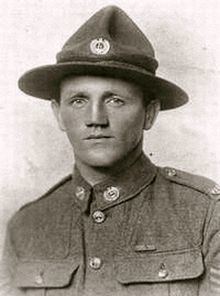Allegiance Role Armed force officer Name Henry Nicholas Service/branch New Zealand Army | Battles/wars First World War Battles and wars World War I Years of service 1916–1918 | |
 | ||
Born 11 June 1891Lincoln, New Zealand ( 1891-06-11 ) Unit Canterbury, and Nelson-Marlborough and West Coast Regiment | ||
Henry James Nicholas (11 June 1891 – 23 October 1918) was a New Zealand recipient of the Victoria Cross, the highest and most prestigious award for gallantry in the face of the enemy that can be awarded to British and Commonwealth forces, which he received during the First World War. He was later awarded a Military Medal for his actions during engagements with the enemy from late September to early October 1918. He was killed in action three weeks before the end of the war.
Contents
Early life
Nicholas was born in Lincoln, near Christchurch in New Zealand on 11 June 1891. He was educated at schools in Christchurch, first at Christchurch Normal School and later at Christchurch East School. After completing his schooling, he was apprenticed to become a builder.
First World War
In February 1916, Nicholas enlisted in the New Zealand Military Forces, giving his occupation as a carpenter. He embarked for Europe three months later with the 13th Reinforcements to join the New Zealand Expeditionary Force in France. He was assigned to the 1st Battalion of the Canterbury Regiment with the rank of private.
Nicholas was involved in an attack on Polderhoek Chateau on 3 December 1917. The chateau was atop the Polderhoek Spur, which overlooked the trenches occupied by the 2nd Infantry Brigade, to which Nicholas's battalion was subordinate. The Canterbury and Otago battalions attacked midday but was slowed by heavy machine-gun fire. It was then that Nicholas performed the actions that led to the award of the Victoria Cross (VC). His VC citation read as follows:
For most conspicuous bravery and devotion to duty in attack. Private Nicholas, who was one of a Lewis gun section, had orders to form a defensive flank to the right of the advance, which was checked by heavy machine-gun and rifle fire from an enemy strong-point. Whereupon, followed by the remainder of his section at an interval of about 25 yards, Private Nicholas rushed forward alone, shot the officer in command of the strong-point, and overcame the remainder of the garrison of sixteen with bombs and bayonets, capturing four wounded prisoners and a machine-gun. He captured this strong-point practically single-handed, and thereby saved many casualties. Subsequently, when the advance reached its limit, Private Nicholas collected ammunition under heavy machine-gun and rifle fire. His exceptional valour and coolness throughout the operations afforded an inspiring example to all.
The advance resumed but ground to a halt 150 yards (140 m) short of the chateau where the New Zealanders established a new front line. During this phase, Nicholas moved along the lines, collecting and distributing ammunition. What was left of the Canterbury and Otago battalions was relieved on 5 December 1917. The award of the VC to Nicholas was gazetted in January 1918. He was presented with his VC by King George V at an investiture at Buckingham Palace in July 1918, having been promoted to sergeant the previous month.
During the Hundred Days Offensive Nicholas won the Military Medal (MM) for actions performed in late September to early October during operations on Welsh and Bon Avis Ridges. On 23 October 1918, he was performing guard duty at a bridge near Le Quesnoy when a German patrol encountered his position. He was killed during the ensuing exchange of gunfire. He was buried in the Vertigneul Churchyard on 29 October 1918. The award of his MM was gazetted in March 1919, and the citation made note of his "fearless leadership and contempt for danger".
Legacy
A bronze statue with biographical details of Nicholas was erected on the banks of the Avon River on 7 March 2007, near the Bridge of Remembrance. Mark Whyte from Lyttelton was the sculptor of the statue. In September 2008, a plaque in memory of Sergeant Nicholas was unveiled by the community of Zonnebeke and the New Zealand Embassy in Brussels, near Geluveld, just south west of the area where Nicholas won the VC.
Nicholas' Victoria Cross and Military Medal were given by his mother to the Canterbury Museum in 1932, where they remain on display.
